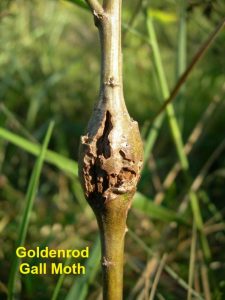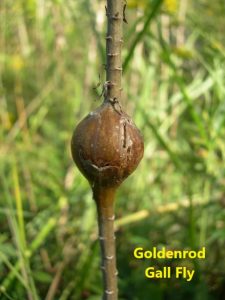 Goldenrods were my Mama’s favorite flower. That is how I know that fall is upon us. At their peak, their brilliant golden yellow flowers make for breathtaking scenes along our roadsides, fallow fields, and many other natural areas that we enjoy visiting during “cooler” weather. And goldenrods come in all shapes and sizes and live in both dry and wet areas. And that is where I ventured every fall, seeking the first of these beauties to give to Mama. Botanically, this group of plants includes a large number of species in several genera (groups of species that share characteristics). Some of our more common species found along our roadsides include the shorter (12-18 inches tall) Flat-topped Goldentop, Euthmia graminifolia and Bushy Goldentop, Euthamia leptocephala. Both of these species are some of the first to show their colors in mid to late September. The taller (4-6 feet tall) goldenrods of our fields and roadsides follow suit and include several species in the genus Solidago – a common species being Canada Goldenrod, Solidago canadensis, one of the most widespread species in the country and Canada. For those of us that venture to tidal marshes along our bayous, look for Seaside Goldenrod, Solidago sempervirens, with their slender, elegant flower heads that rise above the needlerush that dominate this habitat. And if that is not enough, venture out to our barrier islands to see Woody Goldenrod, Chrysoma pauciflosculosa, scattered across the dunes. But these plants are so much more than the harbingers of fall. They are magnets for a wide range of insects that feed upon the pollen. When you take the time to look more closely, you will also find a wide range of other insects, spiders, frogs and lizards that are there to dine on the pollinators. It is indeed a seasonal cornucopia of life. And yet, if you look down below the flowers on the browning stems, you may spot swollen “galls” that are formed by the growing plant to support either the Goldenrod Gall Fly
Goldenrods were my Mama’s favorite flower. That is how I know that fall is upon us. At their peak, their brilliant golden yellow flowers make for breathtaking scenes along our roadsides, fallow fields, and many other natural areas that we enjoy visiting during “cooler” weather. And goldenrods come in all shapes and sizes and live in both dry and wet areas. And that is where I ventured every fall, seeking the first of these beauties to give to Mama. Botanically, this group of plants includes a large number of species in several genera (groups of species that share characteristics). Some of our more common species found along our roadsides include the shorter (12-18 inches tall) Flat-topped Goldentop, Euthmia graminifolia and Bushy Goldentop, Euthamia leptocephala. Both of these species are some of the first to show their colors in mid to late September. The taller (4-6 feet tall) goldenrods of our fields and roadsides follow suit and include several species in the genus Solidago – a common species being Canada Goldenrod, Solidago canadensis, one of the most widespread species in the country and Canada. For those of us that venture to tidal marshes along our bayous, look for Seaside Goldenrod, Solidago sempervirens, with their slender, elegant flower heads that rise above the needlerush that dominate this habitat. And if that is not enough, venture out to our barrier islands to see Woody Goldenrod, Chrysoma pauciflosculosa, scattered across the dunes. But these plants are so much more than the harbingers of fall. They are magnets for a wide range of insects that feed upon the pollen. When you take the time to look more closely, you will also find a wide range of other insects, spiders, frogs and lizards that are there to dine on the pollinators. It is indeed a seasonal cornucopia of life. And yet, if you look down below the flowers on the browning stems, you may spot swollen “galls” that are formed by the growing plant to support either the Goldenrod Gall Fly  (the round galls) or Goldenrod Gall Moth (the elongated galls). In early spring, look for the small round holes in the galls from where the fly or moth emerged to start the cycle anew. And for the countless time, let me AGAIN say to all you allergy suffers – Goldenrod is NOT the cause of your suffering. The pollen of goldenrod is far too big to “fly” into your nose. The culprit is Ragweed, Ambrosia (many species) that is growing in the midst of Mama’s Goldenrods. Ragweed does not have nor need showy flowers because the wind spreads most of its pollen, with much of it ending up in our noses. A price to pay for certain, but do not fear one of the prettiest of our native fall flowers. Go out and celebrate what my Mama looked forward to seeing each year. Hope to see you in our great outdoors!!!
(the round galls) or Goldenrod Gall Moth (the elongated galls). In early spring, look for the small round holes in the galls from where the fly or moth emerged to start the cycle anew. And for the countless time, let me AGAIN say to all you allergy suffers – Goldenrod is NOT the cause of your suffering. The pollen of goldenrod is far too big to “fly” into your nose. The culprit is Ragweed, Ambrosia (many species) that is growing in the midst of Mama’s Goldenrods. Ragweed does not have nor need showy flowers because the wind spreads most of its pollen, with much of it ending up in our noses. A price to pay for certain, but do not fear one of the prettiest of our native fall flowers. Go out and celebrate what my Mama looked forward to seeing each year. Hope to see you in our great outdoors!!!

Subscribe to Updates
Get the latest creative news from FooBar about art, design and business.
Mama’s Favorite Flower – Goldenrod
Mark is a naturalist and wetland ecologist, providing expertise on wetlands, water quality and environmental impacts of humans. He has also developed and conducted a number of environmental education programs and workshops for youth, teachers, realtors, and the general public on a variety of subjects including wetlands, natural history, and environmental landscaping. Mark is a graduate of the University of Southwestern Louisiana (B.S. and M.S. degrees) and Mississippi State University (Ph.D.). Mark is the recipient of the Chevron Conservation Award, the Mississippi Wildlife Federation Conservation Educator Award, the Gulf Guardian Award, and the Boy Scouts of America Silver Beaver Award.


